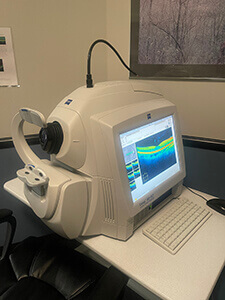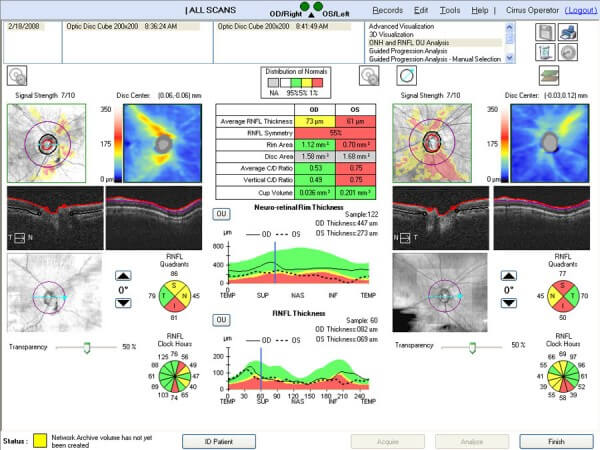What is an OCT eye test – and what does it do?
Posted in Eye Blog, Eye Exam, Medical, OCT test

OCT stands for Optical Coherence Tomography. Simply put, the OCT is a non-invasive tool that “takes pictures of the back of your eye.”
“The OCT is an excellent way to visualize the different layers of the retina and optic nerve in a living eye. Previous to these amazing technologies we were only able to see this view of an eye with tissue sections after the patient was deceased or if the eye was removed. The OCT allows us to diagnose and manage various eye problems like glaucoma and macular degeneration with greater accuracy and sensitivity.” – Dr. Dan Siapco
Another way to think of OCT is that it functions like an ultrasound, except it uses light* – instead of sound waves – to map the shape of the retina and optic nerve. It is safe, non-invasive, and not destructive to tissue. For this procedure, we will first apply dilating eye drops for better results. Then, a camera-like device directs waves of light, which bounce back with an accurate 3-D picture of your eye structure. From a patient standpoint, this simply means you sit at the machine and place your head as directed, and within minutes, the technician will tell you they have the images they need and you go on to the next portion of your eye exam. The device never makes any contact with your eyes.
Here are some examples of the information that Optical Coherence Tomography can provide about your eyes:
Cascadia Eye has an OCT device at all five of our locations. Unless you have glaucoma (or a family history of it), macular degeneration, or diabetic retinopathy, you may never have seen this amazing piece of technology at work.
Here’s a sample of what the technicians and doctors see once the images are taken:

The OCT and your eye health
So what do these colorful pictures mean? A doctor looking at the above image knows what a healthy retina and optic nerve will look like – how thick and/or even it should be, and more. Because the OCT’s map of the eye is three-dimensional, doctors can detect areas of the eye that are abnormal or indicate early damage (for example, if there is a blister of fluid in a layer of the retina), before it has affected the vision of the patient. Early detection means we can treat diseases like glaucoma, or halt the progress of macular degeneration, before they cause irreversible vision damage.
The OCT permits us to diagnose many eye conditions, including glaucoma, macular degeneration, diabetic retinopathy, and various retinal an macular issues.
For a (somewhat amusingly) dated – but informative – look at the OCT when it first came out, you can also watch this video. The technology has gotten even better since then; it is also much more widespread in its use, which is a wonderful thing!
*The light is actually a ‘laser-like’ light source known as a super luminescent diode (SLD).
Contact Cascadia Eye
If you would like to learn more about the OCT, or if you would like to schedule an appointment at Cascadia Eye, please contact us today. We are happy to answer any questions you might have!
In addition, join us on Facebook or Twitter to ask your questions about eyes, exams, and our practice. We’d love to hear from you – and there might be a blog to address your questions in the future.


